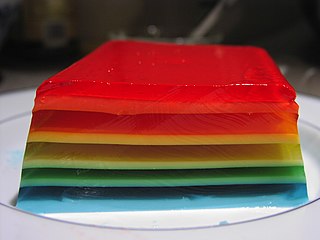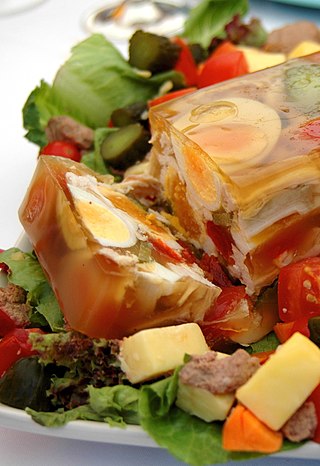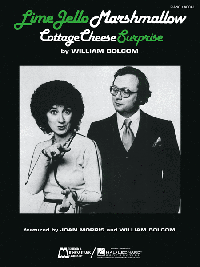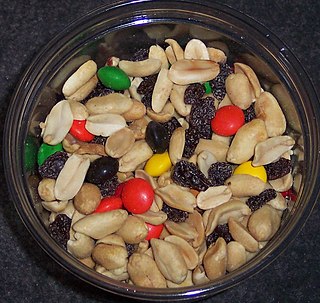
Gelatin desserts are desserts made with a sweetened and flavoured processed collagen product (gelatin). This kind of dessert was first recorded as jelly by Hannah Glasse in her 18th-century book The Art of Cookery, appearing in a layer of trifle. Jelly is also featured in the best selling cookbooks of English food writers Eliza Acton and Isabella Beeton in the 19th century.

Jell-O, stylised as JELL-O, is an American brand offering a variety of powdered gelatin dessert, pudding, and no-bake cream pie mixes. The original gelatin dessert is the signature of the brand. "Jell-O" is a registered trademark of Kraft Heinz, and is based in Chicago, Illinois.

A salad is a dish consisting of mixed ingredients, frequently vegetables. They are typically served chilled or at room temperature, though some can be served warm. Condiments and salad dressings, which exist in a variety of flavors, are often used to enhance a salad.

Head cheese or brawn is a cold cut terrine or meat jelly that originated in Europe. It is made with flesh from the head of a calf or pig, typically set in aspic, and usually eaten cold, at room temperature, or in a sandwich. Despite its name the dish is not a cheese and contains no dairy products. The parts of the head used vary, and may include the tongue but do not commonly include the brain, eyes or ears. Trimmings from more commonly eaten cuts of pork and veal are often used, and sometimes the feet and heart, with gelatin added as a binder.

Aspic or meat jelly is a savory gelatin made with a meat stock or broth, set in a mold to encase other ingredients. These often include pieces of meat, seafood, vegetable, or eggs. Aspic is also sometimes referred to as aspic gelée or aspic jelly. In its simplest form, aspic is essentially a gelatinous version of conventional soup.
Romanian cuisine is a diverse blend of different dishes from several traditions with which it has come into contact, but it also maintains its own character. It has been mainly influenced by Turkish but also a series of European cuisines in particular from the Balkan Peninsula and Hungarian cuisine as well as culinary elements stemming from the cuisines of Central Europe.

Fruit salad is a dish consisting of various kinds of fruit, sometimes served in a liquid, either their juices or a syrup. In different forms, fruit salad can be served as an appetizer or a side as a salad. A fruit salad is sometimes known as a fruit cocktail, or fruit cup.

Iraqi cuisine is a Middle Eastern cuisine that has its origins in the ancient Near East culture of the fertile crescent. Tablets found in ancient ruins in Iraq show recipes prepared in the temples during religious festivals—the first cookbooks in the world. Ancient Mesopotamia was home to a sophisticated and highly advanced civilization, in all fields of knowledge, including the culinary arts.

Ambrosia is an American variety of fruit salad originating in the Southern United States. Most ambrosia recipes contain canned or fresh pineapple, canned mandarin orange slices or fresh orange sections, miniature marshmallows, and coconut. Other ingredients might include various fruits and nuts: maraschino cherries, bananas, strawberries, peeled grapes, or crushed pecans. Ambrosia can also include mayonnaise or dairy ingredients: whipped cream, sour cream, cream cheese, pudding, yogurt, or cottage cheese.
Seafoam salad, also known as orange salad, is a cafeteria and buffet staple popularized by F. W. Woolworth's lunch counters. Seafoam salad is often considered a dessert because of its sweetness, and so is one of many dessert salads. It is composed of green lime-flavored gelatin, cream cheese, pears, maraschino cherries, and whipped topping.

Dominican cuisine is made up of Spanish, indigenous Taíno, Middle Eastern, African, Cuban, Puerto Rican and Haitian influences. The most recent influences in Dominican cuisine are from the British West Indies and China.

Israeli cuisine primarily comprises dishes brought from the Jewish diaspora, and has more recently been defined by the development of a notable fusion cuisine characterized by the mixing of Jewish cuisine and Arab cuisine. It also blends together the culinary traditions of the various diaspora groups, namely those of Middle Eastern Jews with roots in Southwest Asia and North Africa, Sephardi Jews from Iberia, and Ashkenazi Jews from Central and Eastern Europe.

"Lime Jello Marshmallow Cottage Cheese Surprise" is a satirical novelty song by the American composer William Bolcom. It is written for voice and piano, and Bolcom frequently performs it with his mezzo-soprano wife, Joan Morris, accompanying her on the piano. Composed in 1980, it is based on his experiences, in his youth, of playing the piano for women's clubs, and being fed absurd and unappetizing cuisine, including foods resembling Jello salad.

In the United States, a haystack is a dish composed of a starchy food topped by a protein, in combination with fresh vegetables, and garnished with various condiments. Haystacks are conceptually like a deconstructed tostada. The haystacks ingredients are served individually and assembled on the plate by the person who will be eating it.

A snack is a small portion of food generally eaten between meals. A snack is often less than 200 calories, but this can vary. Snacks come in a variety of forms including packaged snack foods and other processed foods, as well as items made from fresh ingredients at home.

A jello shot, colloquially, or Jell-O shot, is a gelatin and alcohol mixture consumed as a shot. The shot is commonly made with vodka or other hard liquors. Shots made with non-branded or unflavored gelatin rather than Jell-O are sometimes known as jelly shots or gelatin shots.

Mosaic gelatin is a gelatin dessert that is popular in Mexico and Brazil. However, it is unclear if it is of Mexican or Brazilian origin. It is sometimes called broken or stained glass gelatin due to its appearance. This dessert is sold at fairs, markets, plazas, and food carts. It can even be found in upscale restaurants. It is popular amongst individuals of all ages, but particularly children because of its colorful, attractive appearance. It can be served at special occasions, and is often found at birthday parties for children. It is a relatively simple and inexpensive dessert to prepare.















